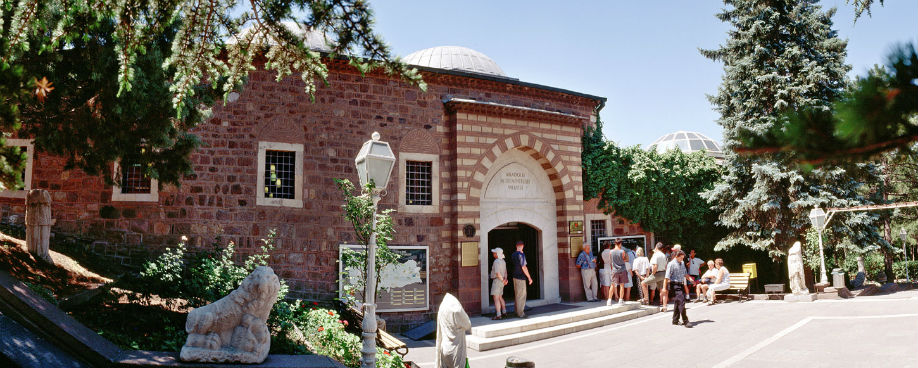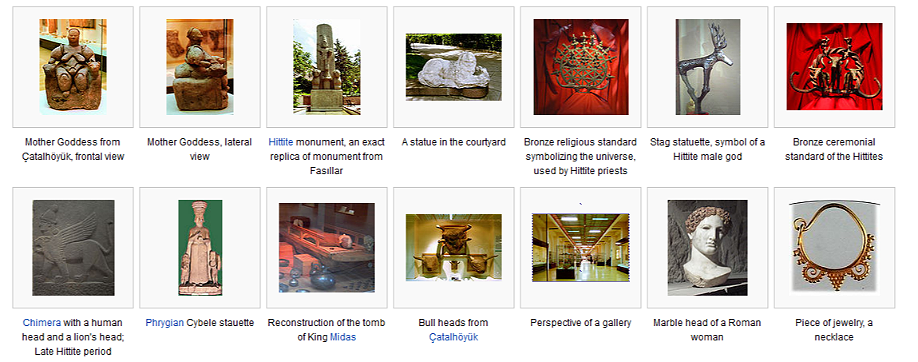The superb Museum of Anatolian Civilisations is the perfect introduction to the complex weave of Turkey’s ancient past, housing artefacts cherry-picked from just about every significant archaeological site in Anatolia.
The museum is housed in a beautifully restored 15th-century bedesten (covered market). The 10-domed central marketplace houses reliefs and statues, while the surrounding hall displays exhibits from the earlier Anatolian civilisations: Palaeolithic, Neolithic, Chalcolithic, Bronze Age, Assyrian, Hittite, Phrygian, Urartian and Lydian. The downstairs sections hold classical Greek and Roman artefacts and a display on Ankara’s history. Get there early to avoid the flood of tour groups and school parties.
The exhibits are chronologically arranged in a spiral: start at the Palaeolithic and Neolithic displays in the room to the right of the entrance, then continue in an anticlockwise direction, visiting the central room last.
Items from one of the most important Neolithic sites in the world Çatalhöyük, southeast of Konya – are displayed here. There’s a mock-up of the inside of a dwelling typical of those uncovered at the site, one of the most famous mother goddess sculptures unearthed from the excavations and wall paintings of hunting scenes.
Also on show are many finds from the Assyrian trading colony Kültepe, one of the world’s oldest and wealthiest bazaars. These include baked-clay tablets found at the site, which dates to the beginning of the 2nd millenium BC.
One of the striking Hittite figures of bulls and stags in the next room used to be the emblem of Ankara. The Hittites were known for their relief work, and some mighty slabs representing the best pieces found in the country, generally from around Hattuşa, are on display in the museum’s central room.
Most of the finds from the Phrygian capital Gordion, including incredible inlaid wooden furniture, are on display in the museum’s last rooms. The exhibits also include limestone blocks with still-indecipherable inscriptions resembling the Greek alphabet, and lion- and ram-head ritual vessels that show the high quality of Phrygian metalwork.
Urartian artifacts are also on display here. Spurred by rich metal deposits, the Urartians were Anatolia’s foremost metalworkers, as the knives, horse-bit, votive plates and shields on display demonstrate. There are also terracotta figures of gods in human form, some revealing their divine powers by growing scorpion tails, and neo-Hittite artefacts.
Downstairs, classical-period finds and regional history displays provide a local picture. Excavations have unearthed a Roman road near the Column of Julian, and Ankara has its own ‘missing link’, the 9.8-million-year-old Ankarapithecus (a 30kg, fruit-eating primate).




We had no idea that the museum was under construction when we went there. Many of the exhibits were moved into the covered courtyard area, but certainly not all of them. While there is plenty to see now, we are going to have to return once their renovation is complete.
Like most museums this one seems to go on for ever! There is so much to see and enjoy. Unless you know about Anatolia it is vital to employ the services of a guide (they stand at the entrance) to fully make sense of everything.
There is a restaurant in the Museum. However far better to continue up the hill…
This is not a huge museum, but one can certainly spend a lot of time discovering all these civilisations that have succeeded themselves in the greater Anatolian region. Beautiful pieces from the bronze and iron age can be seen and they are all presented in a chronological order with simple but clear descriptions.
The building itself, which used to be…
Even though much of the museum was not open when I visited … It was awesome to see what was avaikable of ancient relics of all of the civilizations who have lived in Turkey …
Quite rightly, this museum has the reputation for being one of the best in the world. It houses a collection of artefacts from the very cradle of civilisation and some of the oldest sculptures known to mankind.
Unfortunately and for the foreseeable future, three of the five rooms are shut for renovation and many of the museums most amazing exhibits…
You will learn a lot on the Hittite civilization as well as the Sumerians, Akkadians and so many other civilizations that were born in Turkey. There is a lot to be seen in a park at the foot of the citadel of Kale.
Part of the museum was closed for renovation so we didn't get to see all that we had hoped to see. We loved the rock carvings from various Hittite sites, the fertility objects and the gift shop. We found a lot of unique items there that we hadn't seen elsewhere. The outdoor cafe and art in the garden made it…
if you are there, go and see it. I think it is interesting, but no more than this. However after the Ataturk mausoleum, it is perhaps the more interesting place to visit.
Part of teh museum was closed for renovations so displays may have been more crowded than usual. Howver it was well set out and tehre were some fascinating exhibits which expanded on some of the places we had seen elsewhere on our tour. Mostly well labelled, even if some were a little small to read. set in beautiful grounds with…
Even if they warn you that only two rooms are open, (they are on renovations), go ahed and enter. It is 15 TL and you will not be dissapointed. If you follow the explanations you will have a class on world's history. They have unique pieces worth looking at and do not miss the lower level.